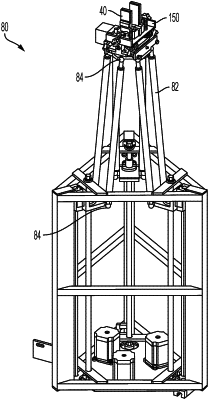| CPC A61B 5/0051 (2013.01) [A61B 5/4509 (2013.01); A61B 5/7282 (2013.01); G16H 40/67 (2018.01); G16H 50/20 (2018.01); G16H 50/30 (2018.01); G16H 50/70 (2018.01)] | 9 Claims |

|
1. A system for estimating the stiffness of a bone in vivo, the system comprising a device for measuring the stiffness of the bone in vivo and a data analyzer:
the device for measuring the stiffness of the bone in vivo comprising a bone support, a mechanical force applicator, and a frequency response recorder, wherein:
the bone support is configured to position and support a skin-bone complex in an orientation and position for measurement;
the mechanical force applicator comprises static and oscillatory force generator, static and oscillatory force sensors, an acceleration sensor, and a force probe and is configured to apply a superposition of controlled static and oscillatory forces (F) over a range of frequencies (f) to a region of the skin-bone complex, wherein the oscillatory forces (F) excite oscillatory accelerations (a) of the skin-bone complex; and
the frequency response recorder is configured to measure and transmit to the data analyzer the oscillatory forces as functions of time F(t) and the oscillatory accelerations as functions of time a(t); and
the data analyzer communicatively coupled to the static and oscillatory force generator, the static and oscillatory force sensors, the acceleration sensor, and frequency response recorder and comprising:
a storage medium containing computer readable and executable instructions for collecting the transmitted oscillatory forces as functions of time F(t) and oscillatory accelerations as functions of time a(t) of the skin-bone complex, the storage medium storing a parametric mathematical model of the skin-bone complex; and
a processor for executing the instructions to transform a(t) and F(t) to functions of frequency, a(f) and F(f), to reduce a(f) and F(f) to accelerance frequency response data A(f), to determine a complex compliance frequency response function Y(f) and associated complex stiffness frequency response function H(f), to fit the parametric mathematical model to Y(f) to obtain a first complete and fully converged set of parameters of the parametric mathematical model, including the stiffness of the bone (KB), to independently fit the parametric mathematical model to H(f) to obtain a second complete and fully converged set of parameters of the parametric mathematical model, including the stiffness of the bone (KB), to determine the discrepancies between the first complete and fully converged set of parameters and the second complete and fully converged set of parameters as a first measure of conformity thereof to the parametric mathematical model, and to determine a second measure of conformity between the skewness of the bone peak in the complex compliance frequency response function and the parametric mathematical model and between the kurtosis of the bone peak in the complex compliance frequency response function and the parametric mathematical model.
|